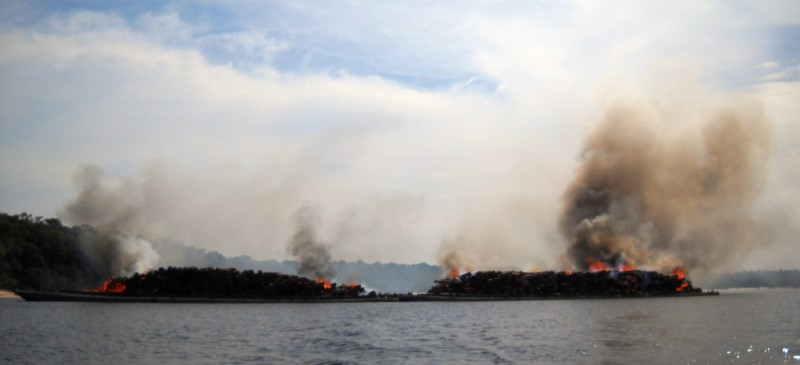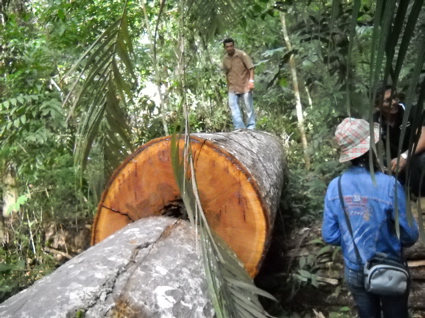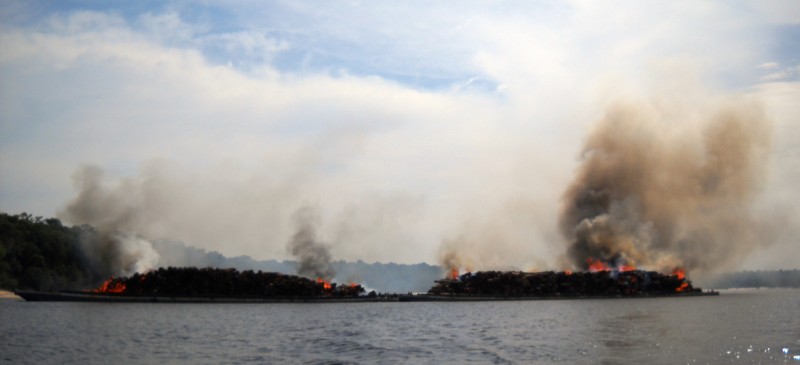 On the Arapiuns River, barges of illegally taken timber smolder after being set aflame to protest logging in Gleba Nova Olinda, Amazon Rainforest. All photos: Brenda Baletti
On the Arapiuns River, barges of illegally taken timber smolder after being set aflame to protest logging in Gleba Nova Olinda, Amazon Rainforest. All photos: Brenda Baletti
While world leaders were meeting in Copenhagen to address the challenge of climate change last month, indigenous and traditional Brazilians in the Amazon region were gathering to defend one the globe’s most important climate-stabilizing resources: the rainforest.
The protesters are battling against the evisceration of their homelands by illegal logging. At the root of the conflict lie two competing conceptions of the rainforest: 1) it can be a place that supports traditional communities and a variety of plant and animal specis; or 2) it can be a source of cheap wood, soy, and beef for global markets.
Just as the Copenhagen effort ended in a frustrating stalemate, the success of this uprising remains very much in doubt. But while the Copenhagen drama involved heated meetings and street protests, blazes are being set and shots being fired in the rainforest.
Showdown on the River
Early one morning in late November, a group of 30 people set out by motorized canoes from the community of Santa Maria of Uruará, in the lower Brazilian Amazon to the junction of the Tamataí and Uruará Rivers, at the boundary of the Extractive Reserve Renascer. The group set up a camp on the riverbank in order to do what the government has not–block illegal loggers who have been taking wood from inside the reserve.
In June of 2009, after more than a decade of conflict between the traditional riberinho (river dweller) communities of the region and loggers and commercial fishers, the Renascer Extractive Reserve was created, albeit at half of the size that the communities had requested. The size was limited in order to accommodate logging and mineral interests, according to government officials involved with the process.
But the creation of the reserve changed nothing—illegal loggers protected by armed gunman have continued to extract timber from inside the reserve’s boundaries. The state and federal government agencies (SEMA and IBAMA respectively) say they have no resources to monitor and enforce restrictions inside the reserve. In fact, after the creation of the reserve, the number of timber barges leaving the area actually increased; until the locals started blocking shipments of logs, up to five barges per day were floating down the river with a total of up to 5,000 cubic meters of wood illegally logged from the reserve.
 Indigenous river dwellers Gleba Nova Olinda, at the site of the protest. The camp that started in late November quickly grew to hundreds of people, blocking passage of river barges and waiting for government agents to come and negotiate with them. What started as a few hammocks strung up in a muddy, mosquito-ridden forest has grown to a village. They cleared out the brush, and each family built a makeshift house from plastic and wood and dug a fire pit. They take turns fishing, and periodically one of them sacrifices a cow to feed the group.
Indigenous river dwellers Gleba Nova Olinda, at the site of the protest. The camp that started in late November quickly grew to hundreds of people, blocking passage of river barges and waiting for government agents to come and negotiate with them. What started as a few hammocks strung up in a muddy, mosquito-ridden forest has grown to a village. They cleared out the brush, and each family built a makeshift house from plastic and wood and dug a fire pit. They take turns fishing, and periodically one of them sacrifices a cow to feed the group.
Because the protesters prevented barges from floating down the river for more than a month, the thwarted loggers began to retaliate. Their planes periodically make threateningly low flyovers; loggers in passing boats yell threats. One night, five men set fire to brush next to the camp.
The Jaurú logging company attempted to bribe the community members to let wood pass down the river. When their offer was rejected, the company hired gunmen to accompany their barges to market. In the early morning of Jan. 3, five log-laden barges set forth, accompanied by 40 armed men. When they reached the encampment, they opened fire on the sleeping, unarmed protestors. Two people were shot. The victims were rushed to the hospital; they survived.
Loggers Call the Shots
The demonstration at Renascer was in part inspired by action taken a month earlier and 100 miles to the west, in an area called Gleba Nova Olinda at the source of the Arapiuns River. On Nov. 12, people from over 40 indigenous and traditional communities–frustrated after more than a decade of failed negotiations with the state for territorial rights, and increasingly suffering threats and attacks against their leaders–closed the Arapiuns River to logging traffic and sequestered two barges full of timber. The protestors camped on the river’s edge for a month as they waited, to no avail, for state and federal governments to arrive and address the problem. Finally, they set fire to the 2,000 cubic meters of wood on the barges. The fires blazed on for three days.
Over the last 10 years, logging has increased dramatically in the west of Pará, where both of these conflicts are located. Pará is a state in lower Brazilian Amazon that is larger than most countries and is notorious for violent land conflict. The incursion of logging into their territories there has resulted in traditional and indigenous people demanding land rights as a way to protect their communities. But the people have grown increasingly frustrated at the government’s unwillingness or inability to protect their homelands; often, land rights are not granted, reserves are not protected, and laws and management plans are not enforced.
In some cases, the government is asking for GPS coordinates and photos to prove that illegal logging is taking place—a totally unrealistic request of people who have on average studied to a fifth-grade level, live from subsistence and small-scale market agricultural production, and have only recently gotten gas-powered motors that provide electricity to their homes. Even when NGOs and outside researchers collect this data, it frequently comes to naught, because officials never follow up and because laws are written or circumvented in favor of logging interests.
So the river dwellers and other indigenous people are taking matters into their own hands, trying to stop the injustices committed against their communities. Ironically, they’re now the ones being branded as criminals.
In the case of the Renascer encampment, the loggers got a municipal judge to issue an order saying that the camp must be disbanded or the people imprisoned. Two weeks ago, the police began an action to put six of the leaders from the Arapiuns in “preventative prison,” which would lock them up indefinitely until they are exonerated of all charges. Such imprisonment is normally imposed on people who are at risk of fleeing or who lack physical addresses and jobs, neither of which applies to these leaders.
 Illegally logged wood inside of the Renascer Extractive Reserve.This sort of punitive action accomplishes two things—it robs the movement of its leadership, and it diverts the movement’s time and energy into a legal battle, distracting from its larger goal of fighting for land rights and curbing illegal logging.
Illegally logged wood inside of the Renascer Extractive Reserve.This sort of punitive action accomplishes two things—it robs the movement of its leadership, and it diverts the movement’s time and energy into a legal battle, distracting from its larger goal of fighting for land rights and curbing illegal logging.
Thus are the power relations in rapidly industrializing Brazil. For people in the United States, tussles over territorial rights and protest camps can seem provincial and distant—regrettable, yes, but in a world overflowing with injustice, not cause for excessive concern.
But the Amazon is not your average disputed territory. In recent decades, tropical forests have absorbed 20 percent of global fossil-fuel emissions, and the Amazon has been the biggest carbon sink of them all, absorbing nearly 2 billion tons of carbon dioxide a year. The river dwellers aren’t defending a vision of the rainforest as a pristine carbon sink, but rather as a homeland that can support a broad range of species and vegetation, including humans. That might not be what Western environmentalists what to hear, but it’s surely a more ecologically responsible vision than clear-cutting followed by vast soybean monocrops.
As climate change charges forward, illegal logging in the Amazon doesn’t just harm the rainforest’s indigenous residents. It imperils us all.



